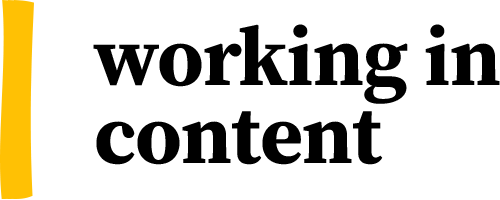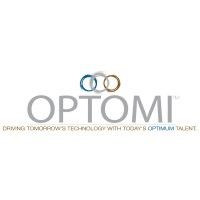On this page:
- Career history, at-a-glance
- Early career
- Jonathan moves into a formal content strategy role
- Forming LendingTree’s first Diversity and Inclusion Group
- What is unconscious bias?
- Leading content design at Red Ventures
- Advice, recommendations and tips from Jonathan
- Jonathan McFadden: Further reading, listening, and watching
Jonathan McFadden is a writer, speaker and Diversity, Equity and Inclusion (DEI) advocate who works as a Senior Content Designer at Red Ventures. Day-to-day, he leads a team that uses words, research and design thinking to build a better UX across branded web experiences.
And when he’s not working with words at Red Ventures, he’s writing them for private clients as the owner of Jon Writes.
We caught up with Jonathan to learn more about his career path to date. Why did he make the transition from ‘roving reporter’ to content strategist? How did he help to start real conversations about diversity and inclusion at an enterprise organisation? And what advice does he have for any budding content strategists and designers out there?
As usual, we’ve included a large helping of insight, tips and honest experiences from our profile subject. Read on to find out more about what makes Jonathan tick at work, how he sees content as an important connector of people, and why speaking at Confab was a professional highlight for him this year.
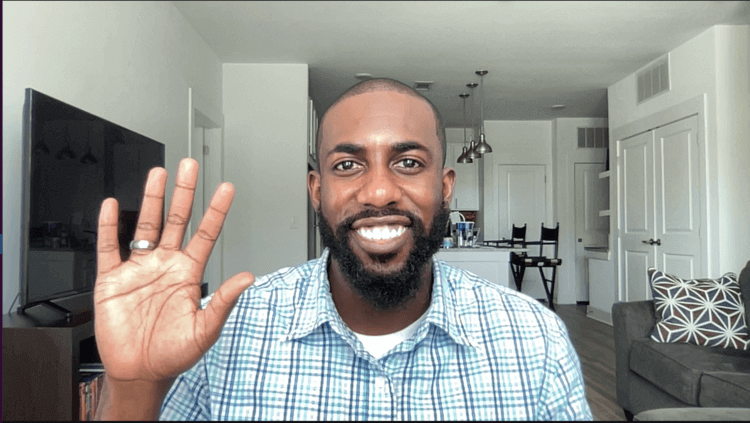
Career history, at-a-glance
Red VenturesSenior Content DesignerApril 2021 - Present
LendingTreeSenior Content StrategistFebruary 2020 - March 2021 (1 year, 2 months)
LendingTreeContent StrategistApril 2018 - February 2020 (1 year, 11 months)
Movement MortgageCopywriterMarch 2016 - March 2018 (2 years)
The Charlotte ObserverCounty Government ReporterJune 2015 - February 2016 (9 months)
The Charlotte ObserverSmall Business ReporterAugust 2014 - June 2015 (11 months)
The (Rock Hill) HeraldCrime and Public Safety ReporterFebruary 2012 - August 2014 (2 years, 7 months)
The (Rock Hill) HeraldFreelance Writer/ReporterJuly 2011 - January 2012 (7 months)
The JohnsonianNews EditorAugust 2008 - May 2012 (3 years, 10 months)
![The Chester News & Reporter logo]() The Chester News & ReporterFreelance Writer/ReporterJuly 2011 - January 2012 (7 months)
The Chester News & ReporterFreelance Writer/ReporterJuly 2011 - January 2012 (7 months)![The Chester News & Reporter logo]() The Chester News & ReporterIntern ReporterMay 2011 - July 2011 (3 months)
The Chester News & ReporterIntern ReporterMay 2011 - July 2011 (3 months)
Early career
Jonathan began his career working as a journalist for several different newspapers, with three of those years spent specifically as a crime reporter.
“I wrote about murder and mayhem every day. It was gruelling, yet it was still incredibly rewarding. It honed my writing and research skills, but it also taught me how to really listen and talk to people. Compassion and empathy made me a better storyteller - and human - and because I infused those qualities into my work, I got the stories no one else did.”
Jonathan also believes that working as a reporter better prepared him for his later career in UX and content design.
“When I was dealing with reporting on murders and violent crime, I felt it was my duty to give victims’ loved ones the space to talk about them so they could be properly memorialized in the newspaper with some dignity. I think that has since translated very well into my job as a content designer, in that empathy and compassion have to underpin everything that we do.”
A move to The Charlotte Observer in 2014 marked a formal move away from crime reporting, as Jonathan was tasked with covering small business news (and later, political news), but his background as a crime reporter somewhat overshadowed what was meant to be his new remit. Even though he covered business and county government, he still wrote crime-related stories, some of which were challenging to report.
“In 2015, Dylann Roof walked into a (historically Black) church in Charleston, South Carolina on a Wednesday night during Bible study, and killed nine Black parishioners. This was a racially-motivated crime. A hate crime.
“I was working in Charlotte at the time, which is about three hours away from Charleston, but it was still close enough that my paper was like, ‘We need to be writing about this’. So I remember the night it happened, I was on the phone trying to confirm the identities of people who were killed and, you know, having to compartmentalize my own pain and my own struggle with that, because as you can see, I'm Black.
“I'm a Black person who goes to church regularly. I'm a Black person who could have been in any Bible study where some white supremacist could have walked in and just shot us all down in a hail of gunfire. I have family members and friends who attend Bible study all the time, or who are just Black in this world and existing, and their lives are constantly endangered. It can weigh heavily on you.”
Jonathan had worked in several reporting positions between 2011 and 2016, working long hours (including some holidays and weekends), and dealing with a number of harrowing news events such as the one he describes above. By 2016, he had started to think about his next career move.
“I thought, ‘Surely there is something else out there that I could be doing with my skills; something that would allow me to enjoy my life?’, because at that time, I wasn't really. I didn't have much time to myself at all.”
Jonathan left the media business that year, feeling that he wanted to do work that aligned more clearly with his personal beliefs and values. He explains that he felt guilty about it at the time, because fellow journalists he admired and respected told him he was destined for great things as a reporter.
“I had colleagues telling me ‘Jonathan, you're so good. You'll land at The Washington Post, or you'll go to the New York Times, you’re that good! You can do that!’ And when people kind of gas you up in that way, you feel like you want to meet those expectations.
He dealt with such a profound crisis of conscience that he went on a self-described “apology tour.”
“I contacted specific people to tell them what I was doing - basically apologizing for making a decision for myself! And not a single person said, ‘Oh, I'm so disappointed in you, Jonathan’ or ‘You're letting me down.’ They all said, ‘Congratulations, good for you. I'm happy for you.’
“Now I look back and think ‘Jonathan, why did you care so much? Why did that approval from others matter so much?’ That was the kickstarter to a journey of personal growth for me. From that point on, instead of trying to live up to someone else's expectation, I lived up to my own.”
Jonathan was sure that, for his next gig, he didn’t want to take on a PR-related role, having previously worked in the media. So, he set his sights on a job in corporate communications and copywriting.
“Someone I had met while in college reached out to me on Twitter. He asked me to refer him to a good writer, because he was looking for writers to join his team. He’d recently become the director of communications at a mortgage company, Movement Mortgage.
“I’d heard of the company, and I knew that it was trying to convey itself as something very innovative, for an organisation of that kind. Movement Mortgage had this mission - it was along the lines of existing to ‘love and value people’. The company talked about itself in a way that felt so different, so atypical. It intrigued me. So, in response to his message, I was like, ‘Yeah, I sure do know somebody - me!’”
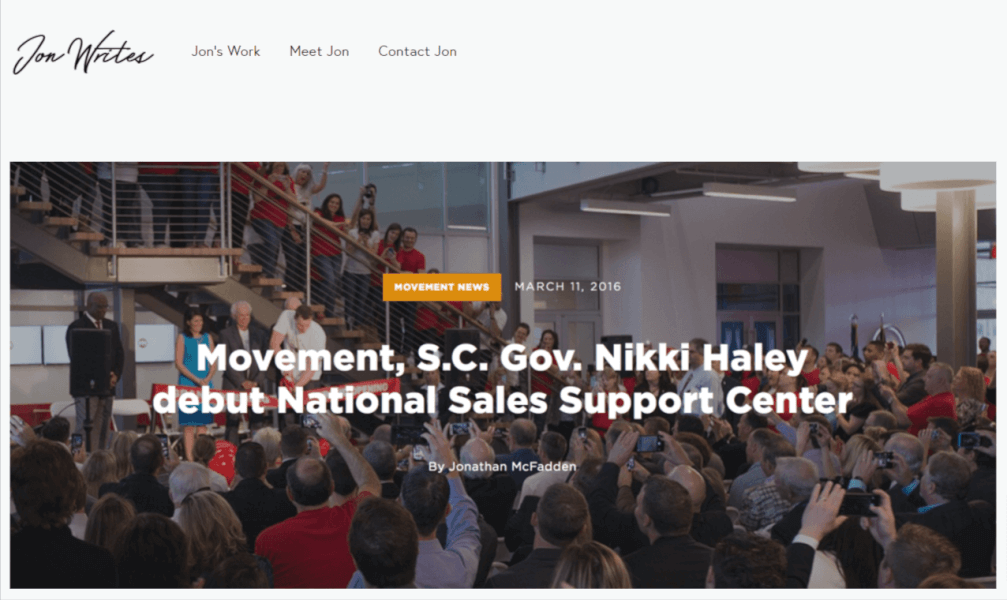
He soon landed a role there as a copywriter, but the remit was larger than just writing copy. Jonathan acted as their ‘brand storyteller,’ conveying the Movement Mortgage story using a variety of formats, producing marketing content for their loan officers, devising email campaigns, writing advertisements, and creating content for their social media.
“Maybe a year or so later, I launched a business called Jon Writes, writing for clients on the side. I still do that today, and it’s allowed me to keep my hand in some of the journalism stuff that I still really enjoy.
“To that end, I've been able to write about gentrification and affordable housing and racism. Those are things I care about. Plus, I'm able to turn down and reject assignments that I'm not interested in, so I feel like I have regained control and power over what I work on journalistically.
“It's not perfect though; there are still times when I slip back into the, ‘Ok, well, I don't want to let people down’ way of thinking, but then I remember, ‘Wait a minute. I don't want to let me down!”
“And I think, are you going to be remembered for all the things you've done because other people said you should do it, or are you going to be remembered for the important decisions you made that actually made an impact and a difference in the lives of the people around you? That’s definitely a driving force and a motivator for me.”
I think the best way to illustrate the esteem I hold for Jonathan's writing is this: He's the only writer I trust to convey my story to the world. He's the only writer with the sensibility, tact, and insight to handle the telling of such a tall tale. He explores the angles and takes the time and care to dig deeper and find the real story beneath the facade. I've always known him to be the first to offer advice, education, and prayers, while also having the dedication to put in the time to wring every last nuance out of a line of words. If you need a writer that's humble enough to learn your voice and tell your story, you couldn't find a better one than Jon.
source: LinkedInJonathan moves into a formal content strategy role
Jonathan goes on to set the scene for his next job; this time at LendingTree, a FinTech company that offers a diverse range of financial services.
“I didn't know what ‘content strategy’ was. I’d never really heard of it before. Looking for a new job in 2018, I saw the role of ‘Content Strategist’ advertised and I was like, ‘Ok, this is something I think I can do...’, but it was definitely going to be work that was at a different scale and level.
“It felt like there might be more opportunity there to expand my knowledge and more room for things like ideation and brainstorming, and being a part of big initiatives (one from the get-go would be working on their app). So, I didn't really understand the full scope of what that role was at the time of applying, but it all sounded really cool.”
Jonathan interviewed for the position and got it. It marked the start of what would become an enduring theme in his long-term career: being entrenched in a world of content strategy and user experience (UX).
“I knew what UX was and I’d heard of it before, but in my previous roles, it was never part of my job. But it was everything at LendingTree because it was a FinTech company with a FinTech product, so I was involved in helping market that product while dabbling in user experience content.”
“In my first few months, I was doing some UX and product work and hadn’t yet realized that that was content strategy. And I was writing microcopy, but not realizing that it was called microcopy!”
After nearly two years in the role, Jonathan was promoted to Senior Content Strategist. It was a reflection of the level of work he delivered and the contributions he made across the company
“By that time, I had helped start (and was managing) our corporate blog, because LendingTree didn't have one. There were actually only two people (my manager and me) doing the kind of work that we were doing - and we supported the entire organization.
“I felt like we were making such a difference, and people in the company realized how important and influential we’d become. I didn’t ask for the promotion, though - it just came up as part of my annual review.
“That's when I really started to understand that I was doing a lot of UX work and product stuff, and I wanted that to be recognized. I wanted that to be an even bigger part of my job.”
Jonathan thought of himself as a ‘hybrid employee’ of sorts, continuously pulled back and forth between ‘marketing’ and ‘product’.
“It wasn't completely an even split, though. I'd say it was probably 60% marketing and 40% UX/product, but to be honest, I was really invested in doing more of the product stuff. I made sure that I kept working closely with the UX team or the UX designers. I kept learning, going to things like the Confab event, and reading great books like Writing is Designing.
“Even from a distance, I was getting to know people in the industry, and I realized that I was doing something that I really wanted to do.”
 Writing Is Designing: Words and the User Experience
Writing Is Designing: Words and the User ExperienceWithout words, apps would be an unusable jumble of shapes and icons, while voice interfaces and chatbots wouldn't even exist. Words make software human–centered, and require just as much thought as the branding and code. This book will show you how to give your users clarity, test your words, and collaborate with your team. You'll see that writing is designing.
After his promotion, Jonathan feels he really drove himself in defining what this senior role meant for him.
“So, for instance, for a couple months in 2020 especially, I basically thrusted myself into people’s business. I would invite myself to meetings. I would have meetings with product managers, send them articles, and constantly be working on trying to convince them of the value of having a writer in the room at the start of their projects.
“I found myself, as a senior-level employee, advocating for my role. I was even ‘loaned out’ to our UX organisation at one point, to help them work on the beginning phases of some projects.”
Jonathan says his role at LendingTree held some similarities to his previous reporting roles in the media — the key commonality being that ‘relationship-building’ was essential in both worlds.
“As a reporter, I had to build relationships and rapport with sources. I covered the police beat for a bit, so that meant I had to get to know the cops and lawyers really well. I had to meet them and talk to them. I had to evangelize what I was trying to do and convert them. I had to let them know that ‘you need me like I need you.’
“It worked then, and it worked for the Senior Content Strategist role too. Eventually, people were coming to me before there were any new projects officially on the books.
“I was getting invited to a whole lot more meetings and my calendar quickly filled up. I was in back-to-back meetings almost every single day. And while it was overwhelming at times, I was also happy because I knew this meant I was doing something right.”
Jonathan says that the progress he felt he’d made helped him feel more confident about calling himself a senior content strategist. He felt as though he was truly doing the work - and doing it the way that he should have been doing it all along.
“Self-advocacy was a real part of what I needed to make things work in my job. You have to be able to speak up for yourself in a lot of organisations, because content strategy is new to everyone who isn’t a content strategist. They don't quite understand it, and they don't quite get why a writer would be needed ‘at this juncture in our project’, but it's our responsibility to teach them.
“I know that that can feel cumbersome, but we also have to understand that our non-UX/content strategist colleagues are users as well - so we should treat them that way.
“And generally speaking, I'm a firm believer that content strategists/designers stand on the frontlines of inclusion, accessibility and representation. So, who better than the writers in the room to make things easier for stakeholders to understand?
It’s rare that you come across standout talent like Jonathan. I’ve had the pleasure of working with Jonathan at Movement Mortgage, collaborating on several projects. Jonathan is a top-notch researcher and interviewer which lends to his ability to tell Movement’s story with confidence and thoughtfulness. Not only does Jonathan excel at storytelling, but brings a smile to anyone he meets. Jonathan earns my highest recommendation.
source: LinkedInForming LendingTree’s first Diversity and Inclusion Group
In 2019, Jonathan joined a small group of employees who banded together to start LendingTree’s first Diversity and Inclusion Group, or DIG as employees called it. They wanted to create an alliance that acted as a resource to help teammates feel seen, heard and respected while also advocating for representation, equity and inclusion at all levels of the organization.
For Jonathan, that work became especially resonant as he spoke with colleagues on the receiving end of microaggressions.
What does ‘microaggression’ mean?
Microaggression is a term used for commonplace daily verbal, behavioral or environmental slights, whether intentional or unintentional, that communicate hostile, derogatory, or negative attitudes toward stigmatized or culturally marginalized groups.
source: https://en.wikipedia.org/wiki/Microaggression“As I'm hearing these stories, I'm asking these individuals, ‘Hey, we're thinking about setting up a Diversity and Inclusion Group. Would you be interested in joining, so that we can help the company avoid some of these cultural landmines that people here step on?’
“Coming together as a group, we decided that we would galvanize and coalesce and that we would do everything we could to make this group happen.”
Jonathan and his colleagues spent a few months researching the impact diversity has on a company’s bottom line — a line of thinking they felt would resonate with the C-Suite. They brainstormed a leadership structure for the group and developed ideas for how LendingTree could offer DEI-related programming for employees. They presented it to the head of human resources, who immediately sanctioned the group’s creation.
“I think it was music to her ears, and she seemed really relieved that a group of employees had gotten together to do this. And it was very much a grassroots effort; we didn’t receive any kind of mandate from the executive team.
“For the presentation, we thought about what our focus areas should be. We decided to take a two-pronged approach - one that would address cultural celebrations and special days, things like that, and one that would address what we perceived as disparities in leadership when it came to race and gender; pay gaps; and representation gaps we saw - at all levels of the company.”
From there, things took off with the group. In commemoration of Martin Luther King Jr. Day, they created an MLK Day of Service - a day in which employees were encouraged to volunteer at local nonprofits. They organised activities and communications in recognition of other annual events such as Black History Month and Women's History Month. Then, just as they were preparing to make a big company-wide debut with a TED Talk screening and dialogue event, COVID-19 sent the world into lockdown.
“We thought, ‘What do we do now? How do we do a diversity and inclusion group when we can't even be in the office together?!’”
The group didn’t have much time to find an answer before another incident reignited their efforts.
“In May 2020, George Floyd was killed by a police officer in Minneapolis. That changed everything. It prompted us to launch a new ‘Diversity and Inclusion’ Slack channel, and we organised Zoom discussion groups where employees were able to talk about their feelings in the aftermath of George Floyd’s murder.
“I would say that maybe what happened brought more attention to the resources available from our Employee Assistance Program too. And we encouraged people to make use of counseling services offered through LendingTree’s health insurance benefits.
“So we did those kinds of things, we had those kinds of conversations and we gave people space to feel. We gave people space to have the conversations that they were just not used to having at work.”
Over the next few months, Jonathan describes the group as growing into its own ‘living organism’.
“We created a leadership structure for the group and a general assembly, of sorts. We held monthly meetings. Some of us attended virtual conferences and connected with DEI experts at different companies. We even had an audience with LendingTree’s CEO, meeting with him every six weeks to talk about our initiatives, get his buy-in and pick his brains.
“We were being invited to multiple meetings and we were basically seen as ‘internal consultants’ on DEI. People would ask us to talk about unconscious bias, and we’d be involved in things like training sessions for hiring managers.
“We had employees leading allyship webinars. We had conversations about issues affecting women, people with disabilities, members of the LGBTQ+ community, members of the immigrant community, people who are neurodivergent. We centered marginalized people groups at the company in a way that was unprecedented. We had open conversations about the insurrection in the U.S. Capitol on Jan. 6 and violence against the Asian American Pacific Islander community after the March shootings in Atlanta.
“We even worked with HR to share demographic data showing racial and gender makeup across the company. It helped give people a view of where disparities did exist, so we could start creating benchmarks and plans to close those gaps. Not many companies are willing to be that transparent and honest about what’s working well and what’s not. I like to believe that forming DIG helped get LendingTree to that point.”
What is unconscious bias?
What is unconscious bias?
Unconscious (or implicit) bias is a term that describes the associations we hold, outside our conscious awareness and control. Unconscious bias affects everyone. Unconscious bias is triggered by our brain automatically making quick judgements and assessments. They are influenced by our background, personal experiences, societal stereotypes and cultural context. It is not just about gender, ethnicity or other visible diversity characteristics - height, body weight, names, and many other things can also trigger unconscious bias. Unconscious bias can have a significant influence on our attitudes and behaviours, especially towards other people. It can influence key decisions in the workplace and can contribute to inequality, for example in selection and recruitment, appraisals, or promotion.
source: https://www.imperial.ac.uk/equality/resources/unconscious-bias/Jonathan thinks that the positive impact of the group could be seen in the culture of the company. It was changing. And as time went on, DIG broadened its scope to include allyship for any marginalized or underrepresented communities.
“This group that started with maybe 40 or so employees initially interested in being involved, grew to more than 370. That was about one-third of the company at the time. And there were many, many challenges along the way; especially as we got closer to the U.S. election. But the progress we’d made… to us, it was amazing.”
“For me personally, it made me feel like I was doing something that really mattered and had positively affected the company on an organizational level. I wasn’t just there to write copy for a product - which was also still very important to me, of course.
"I was like ‘Ok, I'm actually helping to create a sense of belonging for people who work here, hopefully beginning to change some minds, and help spark some crucial conversations."
“So yeah, it was an incredible experience.”
The challenges of forming a DEI group
1. Being seen as leader of the group
LendingTree’s DIG started gaining a lot of momentum. But for Jonathan, the newfound visibility was tricky and sometimes unnerving.
“I don't mean to sound like a narcissist or an egotist by saying this, but it was kind of like ‘being in the spotlight,’ and that's a very vulnerable place to be because now everything you say and everything you do is under a microscope and open for public scrutiny.
“So if you make a mistake or a misstep, everyone sees it. I felt there was this assumption that people are always looking at you to be flawless, but that could’ve been an unreasonable expectation I placed on myself.
“I was always concerned about the language I was using, whether I was being diplomatic enough, whether my tone and my delivery were empathetic enough because I knew people were going to associate me with DEI. Plus, I still had my actual job to do!
“One of the things that helped me through that time was the consensus we had among the five co-chairs of the group; we acknowledged the fact that none of us was perfect or experts, and we communicated that to people in meetings.
“We said, ‘Listen, we're not trying to come here as elitists or people who profess to know it all and have seen it all. No, we are learning right alongside you, and we are not perfect and you're not perfect. So if we do something that offends you, let us know, and we'll own that, and we'll make amends.’”
Jonathan says there were times he said things to colleagues only to find himself questioning whether it came off as a little sharp or brusque.
“But, I always wanted to remain true to myself at the same time, so if I felt something or thought something, I let it be known. I didn't shrink back from what I felt and what my convictions were, and I think people respected that.
“That doesn't mean everybody liked me, but that's OK. You don't do these things to be liked - you do it because it's right.”
Along with forging close bonds with his fellow co-chairs, he also received much-needed support from his wife and a mental health counselor to help him process his feelings. Their listening ears were necessary in moments he felt like he was paying an “emotional tax” as a person of color helping lead a workplace DEI initiative while still fulfilling his primary job responsibilities.
“There were moments where I felt like ‘Hey, I'm really giving a lot of myself to this for free’. I knew I was doing it because I loved it, but there were times when it just felt like a lot to carry.
“There's that temptation to put your feelings off to the side and not deal with it, but I had to deal with it. Going to therapy helped.
“My counselor helped me process my emotions and feelings, and I ended up writing a lot. I wrote a lot on Medium, and it provided a good outlet for me. I wrote about my feelings about corporations and companies suddenly becoming so interested in Black lives after the murder of George Floyd. I wrote about Breonna Taylor. I wrote about my parents and their own racialized experiences. And that was cathartic for me, it really was. It probably kept me sane.”
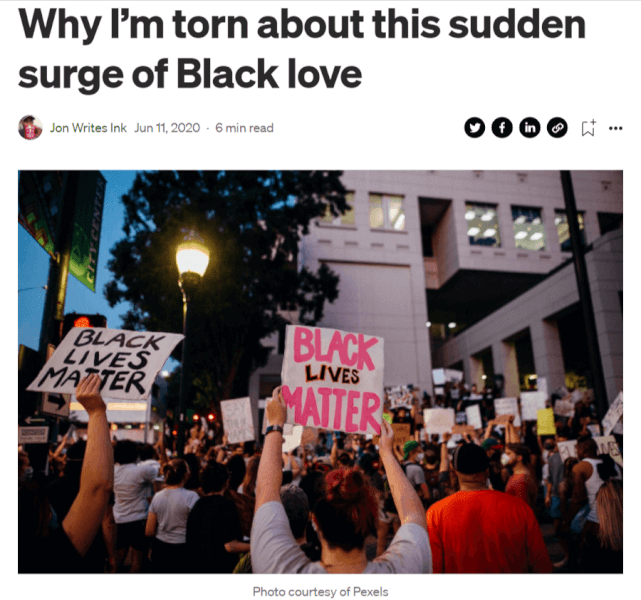
2. Dealing with internal challenges and overcoming obstacles
One of the biggest challenges Jonathan and his fellow co-chairs faced while embedding DEI into the organisation was making sure everybody felt heard and seen, regardless of their beliefs or politics.
“You had people firmly in the DEI camp from the start, which was great, and then you had employees who were very interested in learning about it all; they were just starting to understand these concepts and ideas and needed some help to unpack the nuances of it all.
“Then you had employees who were like, ‘Well yeah, it's important, but do we really need this here? LendingTree is diverse already, and nobody is discriminated against at this company’ - which is obviously not true of any company!
“And then you had those people who basically thought that the DEI group was divisive and causing trouble - a threat to the company culture.
“So, how do you stand firm in the midst of all of that and make sure that all of these people across the spectrum of viewpoints can be heard, respected and represented? You're not just doing this for the employees who are already there with you; it’s also a service and a resource for employees who are not there with you yet.”
That’s why partnership with HR was critical.
“We needed guidance; we were fully aware of that. HR helped us install some ‘guardrails’ in Slack, for instance, to ensure tense conversations didn’t cross the line. There were hiccups and a few emotionally-charged moments, so we had to learn how to respond to that.”
3. Keeping colleagues across the country engaged
Most of LendingTree’s workforce is based in Charlotte, North Carolina, but employees also work in “satellite offices” in Florida, Colorado, California, New York and several other states across the U.S. Even during the pandemic, the company’s headcount increased.
“Employees were scattered all across the country, so we had to figure out how to ensure they felt connected to the same initiative. We had to make sure that the same principles, ideas and values filtered through the entire organization, no matter the ZIP code or the time zone - that was challenging.
“Sometimes, companies with this kind of make-up have employees who may not feel like they're ‘part of the family’, so we wanted to ensure that DEI could, at the very least, be some connective tissue to help LendingTree employees feel more involved in the overall company culture.
“We’d go and meet with these teams and talk to them about DIG. That included people at the companies LendingTree acquired, and you soon get a full view of regional differences. For example, it’s not uncommon to find someone in the Southeast with a radically different viewpoint on an issue than someone in the Pacific Northwest. Those are different cultures entirely. So, we needed to try to strike the right balance so all these people felt like they could take part in DIG.”
Despite the headwinds, Jonathan says helping start and lead DIG was one of the greatest experiences in his career to date.
“I don't regret getting involved in it at all. I'm glad I could be part of it. I'm glad I could help steer it. But, to anybody who wants to do something on that level, my advice would be ‘prepare yourself as much as possible, and also have your emotional safe spaces where you can vent and unload - because you’re going to be taking on a lot.’”
Leading content design at Red Ventures
Jonathan wasn't really looking for a new role when the position of Senior Content Designer at Red Ventures opened up. Red Ventures is a digital media company that owns a large portfolio of brands, including Healthline, CNET, Bankrate, The Points Guy and Lonely Planet, to name a few. (You can read more about the media giant in this recent story from the New York Times.)
Content designers at RV work across a number of brands and partner with other companies to help improve UX on their apps and websites. The chance to get plugged into a substantial community of content designers (RV employs nearly 40) appealed to him.
“A recruiter reached out to me, and we ended up having a phone conversation about the role. I thought it sounded really interesting, and I remember appreciating how Red Ventures had seemed to embrace content design as a practice.
“In a lot of organizations, not everyone understands the value of inviting a writer to the table at the beginning of a project. But based on the chats I was having with the recruiter, and then in my interviews for the role, I could just see that Red Ventures really understood how important content was in creating good user experiences, and the value of having content designers, UX writers and content strategists as part of the team. And I felt ready to take my career in this direction.”
At RV, Jonathan works in a small ‘company within a company’ alongside fellow creatives, developers, product managers, business leaders and others who work to create better user experiences across branded websites. He leads one of the group’s content design teams and manages three junior and mid-level content designers/writers.
“A lot has changed in just a handful of months. When I started at RV, I was the only content designer on my particular team. Another senior joined a month later to lead a parallel content design crew. Then, we started hiring more content designers and writers to stack our content resources. We’ve got two content design teams working for this particular brand, and I lead one of them.
“My team’s responsible for a massive UX web project that’s one of the most challenging and ambitious of my career. I describe our work as a big demolition project. The simplest way to describe it is that we overhaul the stuff that’s not working and, hopefully, make the web experience more intuitive, more empathetic, more useful and more inclusive.
“Content, after all, should create belonging. It should be something that connects people.
"I kind of feel like my job as a content designer is missional; like a calling. It's something that means a lot to me personally."
Here’s something else that means a lot to him: becoming a people manager. For Jonathan, taking on a leadership role has been exciting, nerve-racking and energizing - all at once.
“It’s been quite a change to go from mostly writing to managing and mentoring teammates, creating a vision, spearheading content strategy, getting buy-in from decision-makers, attending a lot of big meetings and building a content design team from the ground up, with some writing in between.”
His current role also gives him the opportunity to influence RV’s overall content design practice. He’s already helped establish some DEI guidelines for RV’s content designers, hosted a series of inclusive writing presentations for content new hires and joined a UX Writing Learning and Development committee.
“I'm now part of a community where there are so many content designers really interested in this work. They’re passionate about it, and want to help amplify it, and that is pretty exciting.”
Jonathan McFadden is one of those people you’ll always remember working with, in the best of ways. He’s a talented writer, an inspiring networker, a relationship builder and empathetic leader. He can’t help but have a cultural impact on any organization he works with. It’s just who he is. It was my privilege to be his manager. He was always open to feedback, eager for growth and had a natural inclination to lead with heart and vulnerability. I learned so much from him, and I like to think we both grew as a result of our relationship. It also helps that he’s my kind of nerdy. Seriously though, if you have Jonathan McFadden on your team, it’s better for it.
source: LinkedInAdvice, recommendations and tips from Jonathan
Which industry professionals should people be following right now on Twitter?
 Candi Williams Head of Content Design @Bumble by day. Honeybee Author by night. Books Fan of words, inclusive design, social justice, food, crystals and wine. #BlackLivesStillMatterBrownFollow @candiwrites
Candi Williams Head of Content Design @Bumble by day. Honeybee Author by night. Books Fan of words, inclusive design, social justice, food, crystals and wine. #BlackLivesStillMatterBrownFollow @candiwrites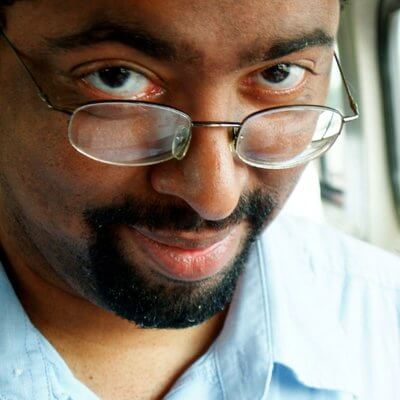 David Dylan Thomas Big fan of treating people like people. Author, Design for Cognitive Bias. Speaker, Lots of Places.Follow @movie_pundit
David Dylan Thomas Big fan of treating people like people. Author, Design for Cognitive Bias. Speaker, Lots of Places.Follow @movie_punditAre there any particular books you’d recommend to someone for early in their career?
 Writing Is Designing: Words and the User Experience
Writing Is Designing: Words and the User ExperienceWithout words, apps would be an unusable jumble of shapes and icons, while voice interfaces and chatbots wouldn't even exist. Words make software human–centered, and require just as much thought as the branding and code. This book will show you how to give your users clarity, test your words, and collaborate with your team. You'll see that writing is designing.
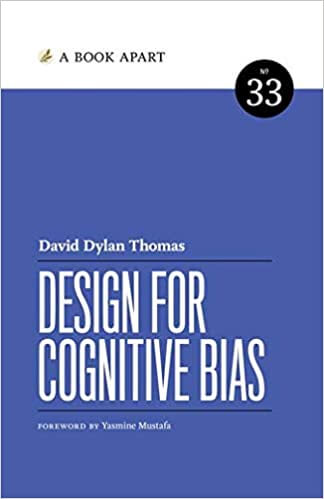 Design for Cognitive Bias
Design for Cognitive BiasWe humans are messy, illogical creatures who like to imagine we’re in control—but we blithely let our biases lead us astray. In Design for Cognitive Bias, David Dylan Thomas lays bare the irrational forces that shape our everyday decisions and, inevitably, inform the experiences we craft. Once we grasp the logic powering these forces, we stand a fighting chance of confronting them, tempering them, and even harnessing them for good. Come along on a whirlwind tour of the cognitive biases that encroach on our lives and our work, and learn to start designing more consciously.
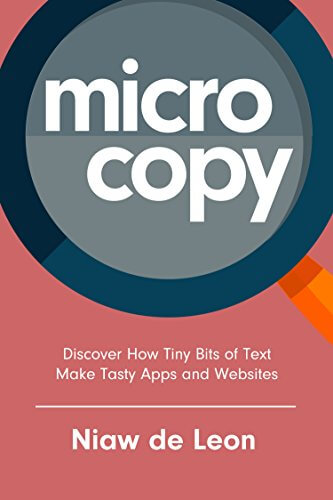 Microcopy: Discover How Tiny Bits of Text Make Tasty Apps and Websites
Microcopy: Discover How Tiny Bits of Text Make Tasty Apps and WebsitesMicrocopy consists of small pieces of text like headings, hint texts, placeholders, summaries, and instructions throughout a website or app. These little bits of content often get overlooked to the detriment of the application or website you’re building, which is tragic since they make the difference between products that fade into obscurity and those that go on to become extremely successful.
Can you name a professional highlight from this year?
“I was a speaker at Confab 2021. My co-presenter, Art Schwartz-Restrepo, and I delivered a presentation on how content people can leverage their power, influence and word bank to advocate for underrepresented and marginalized users.
“Art and I connected during Confab 2020 over our shared passion for DEI and its potential for intersecting with content strategy and UX. I had already been thinking about presenting at an event, so it was a no-brainer when Art asked if I'd like to work together. We pitched our talk, got the go-ahead from the conference organizers and got to work.
“The experience was incredible. Art and I made a great team because we both brought valuable skills - whether it was his top-notch research skills or my human-focused wordsmithing - to the table.
“But I think the greatest reward for me came at the conference itself. To their immense credit, Brain Traffic did an exceptional job transitioning the traditional in-person conference experience to a virtual one in both 2020 and 2021. I attribute a lot of that success to the flourishing Slack community that teemed with activity throughout the conference. And while it was all virtual, those Slack channels helped create community and connection for the hundreds of people who participated.
“I helped create a few of those spaces, such as the ‘Black People at Confab’ channel - an idea I cooked up with Aladrian Goods (Senior Content Designer at Intuit), the ‘People of Color at Confab’ channel (which I first created at the 2020 conference), and the ‘Recovering Reporters’ channel.
“Creating those communities meant a lot to me, especially because several of us connected over Zoom in between sessions, and even weeks after the conference.
“I love ‘community’. I love creating safe spaces. I love meeting new people. Confab let me do all three.
“I should just say here that I usually try not to foist my beliefs and values on other people, but I believe it's a duty of content practitioners to create belonging and reduce harm with our words.
“Speaking at Confab was a significant moment for me because it helped me realize that I have a lot to say, and that there are people willing to listen.
"It’s funny because I'm really an introvert. But, I believe in the power of community and long to help fill the glaring representation gap in our industry. So, I'm unapologetically loud when I've got to be!"
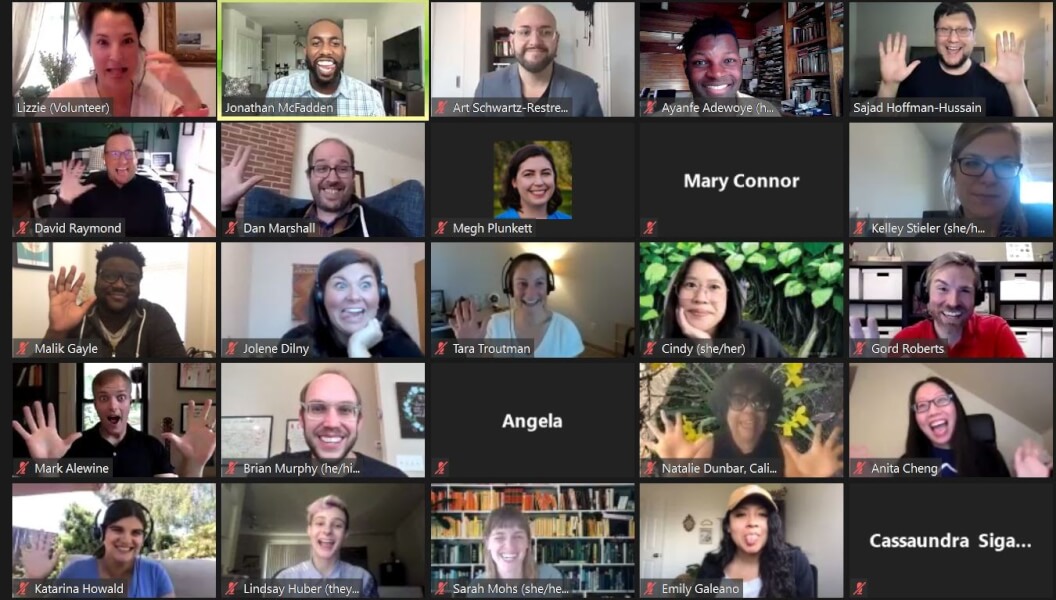
For someone considering a career change into content design, UXW or content strategy (from marketing, journalism etc), what advice would you give them?
“Familiarize yourself with design components.
“When I got the job at LendingTree and started getting more involved with product work, I learned a lot about UX on the fly. That's not an awful thing, but I wish I had taken more time in my marketing job to learn more about what tools our designers were using. Perhaps my learning curve would not have been so steep.
“Also, don't discount your experience, even if it hasn't been overtly centered on UX or content design.
“UX and content design inherently purport to ‘create belonging for people’, but I know when it comes to people who are actually practicing the work, it can feel a little elitist sometimes. I'm a big believer in offering opportunities to more junior people though. You have to start somewhere. We all had to start somewhere...
“Your experience as a news reporter, content marketer, blogger, etc. matters and it's all relevant. Why? Because you know how to talk to people. You know how to put yourself in their shoes. You know how to organize information with hierarchy in mind. You know how to think strategically and make big decisions in a hurry.
“Don't disqualify yourself because the letters ‘UX’ aren't on your resume (yet). This universe is still new to a lot of people. You can do this.”
Everyone experiences imposter syndrome, how do you remind yourself that you absolutely belong where you are?
“This is a constant work in progress for me, but I tell myself that if I wasn't meant to be here, I wouldn't be.
“I don't believe in coincidence or luck. I believe in providence. God gave me a voice and He gave me righteous indignation that won't let me stay quiet, even when I want to. No matter how uncomfortable it makes me, I'm on a mission. That keeps me moving.”
If there’s someone from the content community reading this who’s wanting to start a DEI initiative at their organisation, what would you suggest they do or think about?
“I would say the most important question someone should ask themselves is ‘who else cares about this?’ I think that is the biggest question because I don't advise anybody to take something like this on by themselves. Find your ‘allies’, find people who are just as driven and just as concerned about these issues as you are - they will exist in your organization somewhere.
“So for instance, if your organization uses Slack or Teams (or another messaging network), and you have this really big concern about DEI, put something out there and just see what comes back. Those people who send something back are contacts. Now you have leads, so reach out to those people and get talking to them. You could ask questions like:
What do you think about the organization?
Do you think we could set up a DEI group?
How do you think we could kick this off?
“When you’re having these conversations, you’re also beginning to kind of normalize having these kinds of discussions at work.
“And once you have your group of allies, figure out what setting up a DEI initiative might look like at your company. It might mean that you need to talk to someone higher-up or somebody else who has a little more influence than you across the organization (your line manager, for example) or a direct line of communication with the C-suite.
“Every company has its own unique DNA - its structure and hierarchy. So I can't tell you how to proceed in great detail from there, but you know it better than anyone because you’re there! And once you've figured out what the next steps could be, you can start to put some plans in motion.
“At LendingTree, the culture of the company and its entrepreneurial spirit meant we felt comfortable in the fact that we could actually make something happen. Not every company is that way though - at some other companies, there’ll be blockades and hurdles at almost every level. If that’s the case, you'll have to figure out how to get around that, while keeping your job.
“Also, loop in people like your internal communications manager, so they can include news about what you’re doing in their internal comms.
“And remember that this isn't just around being able to hold Zoom discussions to talk about systemic racism or major news events like the murder of George Floyd. It’s great to be able to do that of course, but ideally, you want it to go beyond that. You want it to affect institutional change, and the only way to do that is to create a larger program where you delegate and are able to hold people accountable.
“Lastly, I just want to encourage anybody who might be reading this article that, whilst my experiences of this will sound laborious and exhausting, I don't want that to be a deterrent to them.
“I don't want that for the person who really cares about this kind of work. I want them to understand that, depending on your situation, depending on where you work, yes, a lot may be required of you, but if you really care about it and you're passionate about it, it's worth it.
“You don't have to do it. But just don't think that something like this will happen anyway if you don't get involved or kick off the conversation about it. I think the bystander effect is real. And I think that the mistake we risk making as employees if no one steps up.”
What is the ‘bystander effect’?
What is the ‘bystander effect’?
The bystander effect, or bystander apathy, is a social psychological theory that states that individuals are less likely to offer help to a victim when there are other people present.
source: https://en.wikipedia.org/wiki/Bystander_effect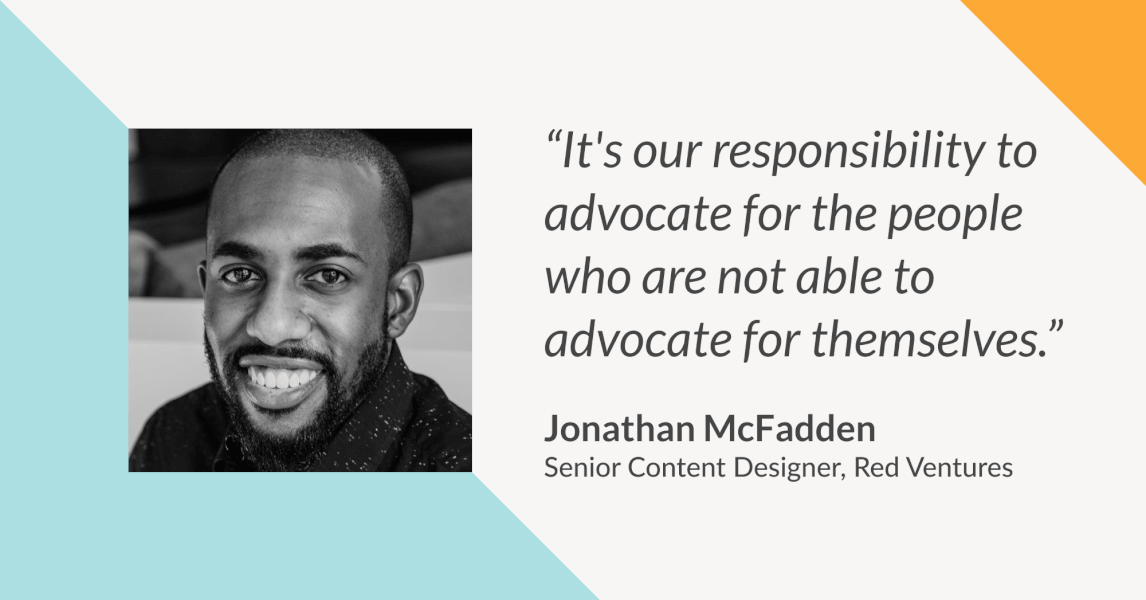
Jonathan McFadden: Further reading, listening, and watching
Jonathan’s LinkedIn profile Connect to Jonathan on LinkedIn.
Jonathan’s website Find out more about Jonathan and what makes him tick.
Jonathan’s Medium profile A collection of writing on everything from UX writing to politics and personal life experiences, including:
Why former journalists should consider a career in UX Jonathan makes the convincing case for why a transition is possible for those currently working in the media industry.
The Content Strategy Podcast (Episode #34) Jonathan talks about using content strategy for change by advocating for underrepresented users and ultimately working towards an inclusive and diverse industry.
